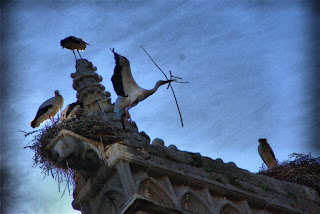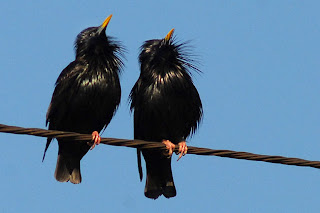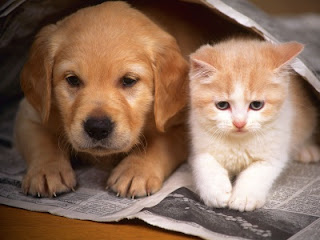Las ciudades constituyen ecosistemas artificiales únicos y la mano del ser humano está presente en cada uno de los espacios de los componen. Sin embargo, muchos animales han adaptado su forma de vida para sobrevivir allí; la basura y los desperdicios les sirven de alimento, y encuentran infinidad de recovecos para refugiarse, descansar y reproducirse sin temores. Al final, muchos de ellos están más seguros en las ciudades, porque allí no habitan sus depredadores naturales.
Las cigüeñas se han adaptado, muy bien, desde hace muchos años a vivir en las torres más altas de las ciudades europeas. Llegan de la mano de la primavera y se instalan en los mismos nidos que construyeron temporadas atrás.
El estornino es un pájaro que se alimenta de lombrices e insectos, aunque también puede comer los restos de alimentos que encuentra a su paso. Por eso, y porque suele adueñarse de los nidos de otros pájaros, se ha adaptado tan bien a la vida urbana.
Las salamanquesas son pequeños reptiles que habitan en las terrazas y los jardines de las ciudades. En sus patas poseen unas ventosas que les permiten adherirse a las paredes y trepar por ellas.
Los lagos y estanques de los parques son frecuentados por aves acuáticas, como patos y cisnes, que además de encontrar un sitio donde zambullirse son alimentadas por los paseantes, a cuya presencia se acostumbran fácilmente.
En las ciudades portuarias es frecuente ver lobos marinos. Los puertos son ideales para estos monumentales mamíferos, porque en ellos consiguen peces y además están protegidos de las orcas y los tiburones del mar abierto, que son sus depredadores naturales.
Los mapaches son carnívoros y usan sus patas delanteras para tomar y sostener los alimentos. Por eso no les resulta difícil encontrar comida en los cubos de basura. Se instalan en las hendiduras de los techos de las casas y allí cuidan a sus crías. También suelen pasearse por los jardines.
Los murciélagos son mamíferos voladores que se han adaptado a vivir en la parte superior de algunos edificios o debajo de los puentes. Producen sonidos de alta frecuencia que, al chocar con los objetos, rebotan y les permiten localizar a sus presas y los objetos de su entorno.
Los alacranes o escorpiones son animales emparentados con las arañas y, al igual que ellas, conviven con los seres humanos en todos los ambientes desde tiempos muy antiguos. Se alimentan de insectos, especialmente de cucarachas, tan típicas de las ciudades. Habitan en los túneles y en las cloacas, donde hay humedad.
Los perros y los gatos son los animales que llevan miles de años en contacto con el ser humano, tanto es así que es difícil imaginar que alguna vez no estuvieron aquí..., los perros están entre los mamíferos más conocidos del mundo y tomaron al ser humano como jefe de su manada en tiempos prehistóricos. Los gatos fueron adoptados y venerados por muchos pueblos de la Antigüedad, y hoy viven casi en su totalidad en los hogares, como mascotas, o libremente en las ciudades del mundo.
Cities are unique ecosystems and artificial human hand is present in each of the spaces of the components. However, many animals have adapted their lifestyle to survive there, the trash and garbage they feed, and find plenty of nooks and crannies for shelter, rest and reproduce without fear. In the end, many of them are safer in the cities, because there is no natural predators inhabit.
Storks have adapted very well, for many years to live in the tallest towers of European cities. They come from the hand of spring and are installed in the same nests they built seasons ago.
The starling is a bird that feeds on worms and insects, but can also eat leftover food that is in its path. For this reason and because it tends to take over the nests of other birds, has adapted well to urban life.
Geckos are small reptiles that inhabit the terraces and gardens of the city. Its legs have suction cups that allow them to adhere to the walls and climb them.
The lakes and ponds of the parks are frequented by waterfowl, such as ducks and swans, in addition to finding a place to dive are fed by walkers, whose presence is usually easily.
In the port cities often see sea lions. The ports are ideal for these monumental mammals, because they get fish and are also protected by killer whales and sharks offshore, which are their natural predators.
Raccoons are carnivorous and use their front legs to grasp and hold food. So I do not find it difficult to find food in garbage cans. They settle in the crevices of the roofs of the houses and raise their young there. They also tend to walk around the gardens.
Bats are flying mammals that have adapted to live on top of some buildings or under bridges. They produce high-frequency sounds, colliding with objects, bounce and allow them to locate prey and objects in their environment.
The animals scorpions or scorpions are related to spiders and, like them, live with human beings in all environments from very ancient times. They feed on insects, especially cockroaches, so typical of cities. They live in the tunnels and sewers, where there is moisture.
Dogs and cats are animals for thousands of years in contact with humans, so much so that it is hard to imagine that once were not here ..., dogs are among the world's best known mammals and took the man as head of his herd in prehistoric times. The cats were adopted and venerated by many peoples of antiquity, and now live almost entirely in homes, as pets, or freely in the world's cities.









No hay comentarios:
Publicar un comentario